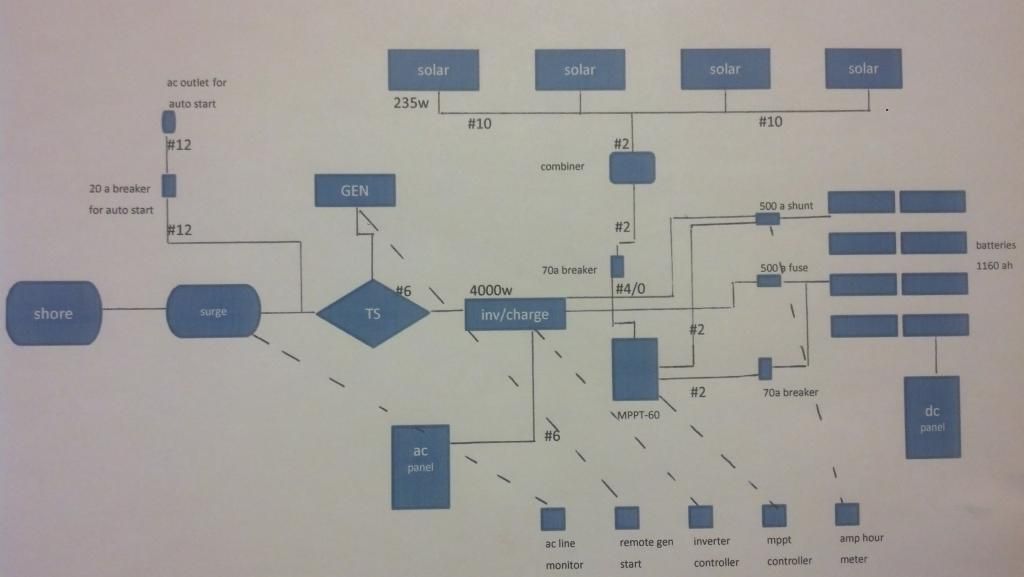- Subscribe to RSS Feed
- Mark Topic as New
- Mark Topic as Read
- Float this Topic for Current User
- Bookmark
- Subscribe
- Mute
- Printer Friendly Page
what if?
- Mark as New
- Bookmark
- Subscribe
- Mute
- Subscribe to RSS Feed
- Permalink
- Report Inappropriate Content
Oct-11-2014 04:40 PM

- Mark as New
- Bookmark
- Subscribe
- Mute
- Subscribe to RSS Feed
- Permalink
- Report Inappropriate Content
Oct-12-2014 05:17 PM
- Mark as New
- Bookmark
- Subscribe
- Mute
- Subscribe to RSS Feed
- Permalink
- Report Inappropriate Content
Oct-12-2014 07:29 AM
tlaffourtit wrote:
I didn't know each panel had to have it's own breaker or fuse. good to know. its a breaker between the combiner and controller so it's a switch as well. the rv is a 30 amp. I believe the inverter is rated at 40 amps. I could be wrong.as far as the 500 amp fuse with the 4/0; I just imitated what we use at work. was just a guess on my part.
Scroll down to how and when to fuse your solar panels
http://www1.cooperbussmann.com/pdf/9df1f7ec-8c62-4210-8cf8-9504927394f0.pdf
on Ford E350-460-7.5 Gas EFI
Photo in Profile
2. 1991 Bighorn 9.5ft Truck Camper on 2003 Chev 2500HD 6.0 Gas
See Profile for Electronic set-ups for 1. and 2.
- Mark as New
- Bookmark
- Subscribe
- Mute
- Subscribe to RSS Feed
- Permalink
- Report Inappropriate Content
Oct-11-2014 10:25 PM
- Mark as New
- Bookmark
- Subscribe
- Mute
- Subscribe to RSS Feed
- Permalink
- Report Inappropriate Content
Oct-11-2014 08:45 PM
Since you posted the diagram...
Technically each panel should have branch fuse... probably 10 or 15 amp.
70 amp fuse between combiner and controller is not really needed but a DC switch might be convenient for service.
You don't state if RV is 50a or 30a but make sure the inverter transfer switch is properly rated.
500a inverter fuse might be a little large for 4/0 wire.
- Mark as New
- Bookmark
- Subscribe
- Mute
- Subscribe to RSS Feed
- Permalink
- Report Inappropriate Content
Oct-11-2014 07:20 PM
tlaffourtit wrote:If your amp meter will take the amperage of the solar controller, the inverter/charger, and the combination of both, measure as mentioned above.
volt/ohm and a hand held amp meter
FWIW, I have a Fluke 600 vac clamp meter that will take the amps. I also have a Fluke handheld that only measures 10 amps. I recently replaced the fuses in the 10 amp model and they weren't cheap.
BTW, BFL is the Guru of multiple charger setups. Approach his mountain top lair cautiously. Otherwise, you will be smitten with multiple chargers and a tangle of battery cables. :B
'71 Starcraft Wanderstar -- The Cowboy/Hilton
- Mark as New
- Bookmark
- Subscribe
- Mute
- Subscribe to RSS Feed
- Permalink
- Report Inappropriate Content
Oct-11-2014 06:50 PM
tlaffourtit wrote:
I see your point to keep the inv off while plugged into shore outlet. converter was removed, rather left dormant just incase inverter ever broke. I am not sure but I don't think my inv/charger has a converter. side note:I did notice I left out the 60 amp breaker between the ts and inv.
Your inverter/charger and shore power should be separated by the inverter portion's internal transfer switch that will just pass through shore power if on.
The charger portion acts like a converter when on shore power and the charger portion of the inverter/charger is "enabled" (turned on)
You could arrange to have the old converter, the inverter/charger, and the solar all adding their charging amps together if you wanted .
on Ford E350-460-7.5 Gas EFI
Photo in Profile
2. 1991 Bighorn 9.5ft Truck Camper on 2003 Chev 2500HD 6.0 Gas
See Profile for Electronic set-ups for 1. and 2.
- Mark as New
- Bookmark
- Subscribe
- Mute
- Subscribe to RSS Feed
- Permalink
- Report Inappropriate Content
Oct-11-2014 06:41 PM
- Mark as New
- Bookmark
- Subscribe
- Mute
- Subscribe to RSS Feed
- Permalink
- Report Inappropriate Content
Oct-11-2014 06:28 PM
I assume you was just talking about having the unit plugged in and solar charging turned on. No harm done. The solar just charges the chassis battery anyway. The converter/inverter/charger box will charge chassis and coach batteries.
12 Chevy Sonic DD, 03 JEEP GRAND CHEROKEE, 2001 Jayco KIWI
If a "nightmare" is considered a dream-then I am living the dream
- Mark as New
- Bookmark
- Subscribe
- Mute
- Subscribe to RSS Feed
- Permalink
- Report Inappropriate Content
Oct-11-2014 05:43 PM
Hensley "Arrow" 1400# hitch (Sold)
Not towing now.
Former tow vehicles were 2016 Ram 2500 CTD, 2002 Ford F250, 7.3 PSD, 1997 Ram 2500 5.9 gas engine
- Mark as New
- Bookmark
- Subscribe
- Mute
- Subscribe to RSS Feed
- Permalink
- Report Inappropriate Content
Oct-11-2014 05:12 PM
- Mark as New
- Bookmark
- Subscribe
- Mute
- Subscribe to RSS Feed
- Permalink
- Report Inappropriate Content
Oct-11-2014 05:06 PM
The best way to see what the results are with your dual charging system is to measure current being distributed to the batteries with only one or the other and also with both charging. This is done with a meter and a DC clamp meter is the best since most handheld meters do not measure above 10 amps. You could also measure voltage at the batteries using the above measuring procedure and get a ballpark estimate. What kind of meter do you have?
'71 Starcraft Wanderstar -- The Cowboy/Hilton
- Mark as New
- Bookmark
- Subscribe
- Mute
- Subscribe to RSS Feed
- Permalink
- Report Inappropriate Content
Oct-11-2014 05:01 PM
15 Mini Cooper S





